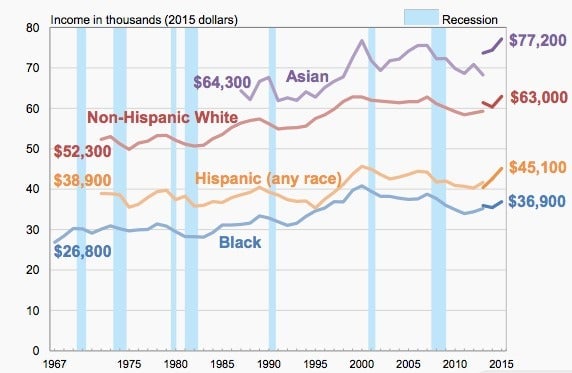The middle-class American family saw the largest income boost on record last year
Despite the bleak picture of a destroyed middle class that presidential candidate Donald Trump has painted, the American middle-class family is doing pretty darn well. Compared to 2014, you might even say great.


Despite the bleak picture of a destroyed middle class that presidential candidate Donald Trump has painted, the American middle-class family is doing pretty darn well. Compared to 2014, you might even say great.
In 2015, the median household earned $56,500, adjusted for inflation, according to the US Census Bureau (pdf). In real terms, that’s equal to a $2,800 rise compared with 2014’s median household income—growth of more than 5%.
That 5% jump is the biggest annual increase in real median household income in the time these data have been recorded, starting in 1968. Last year’s surge was the first statistically significant annual rise in median household income since 2007.
This is a huge deal, particularly this year. Every presidential election is largely a referendum on the economy, and the effectiveness of the incumbent party. Growth in GDP has been sluggish this year, so this upbeat report bodes well for Democrat Hillary Clinton’s prospects. Meanwhile, Republican Donald Trump has made inroads appealing to working class and middle class voters frustrated by their economic prospects.
Of course, GDP and jobs data released this year are more recent than the income data just published by the Census Bureau. That said, these new data offer a strong indication, and some useful context, on how American families are really doing. And that leap in median incomes should come as a big relief for the Democrats.
Incomes are now within striking distance of levels during the height of the housing bubble—and not far off from the frothy years of the dotcom boom. The biggest factor behind the increase is the steady rise in employment—particularly full-time, year-round jobs—says the Census Bureau. Consistent with today’s census data, wages have been rising at a steady clip.

What’s also worth noting is who is doing better. Incomes rose across the board. Back in 2014, only median Hispanic families saw an increase in income, while Asians, blacks, and whites saw their income fall or stay flat. This year, however, all racial groups saw their incomes climb (though the 3.7% increase for Asians was not statistically significant, says the bureau).
As for a generational breakdown, the incomes of millennials and youngish Gen-xers (i.e. those between 25 and 44) surged the most—a much-needed dollop of good news for the workers hit hardest by the Great Recession.
Of course, this likely won’t influence Donald Trump much given that the GOP nominee just said the information we get about the US economy is a sham. Plus, his supporters tend to feel more economic anxiety, even though they’re generally better off than non-supporters.
For everyone else, though, today’s data suggest that America isn’t quite the hellhole of drudgery that Trump insists it is.